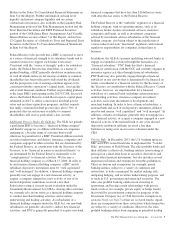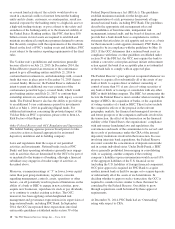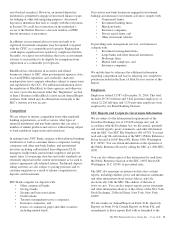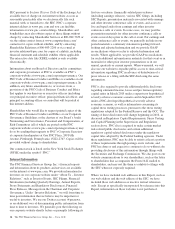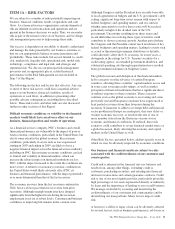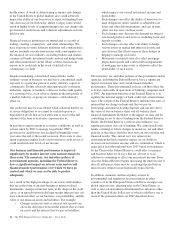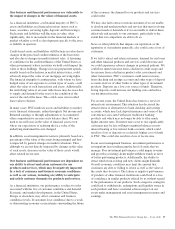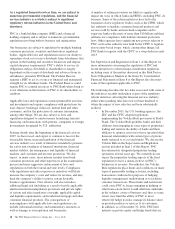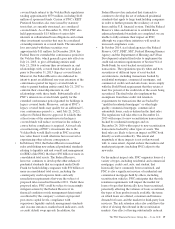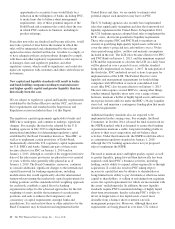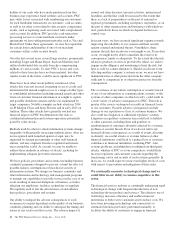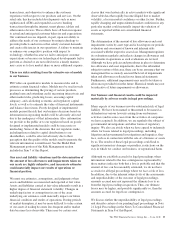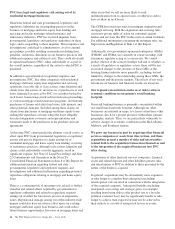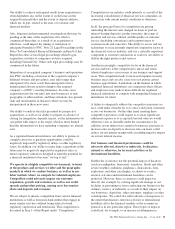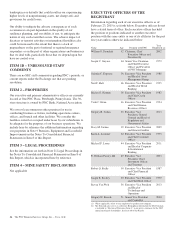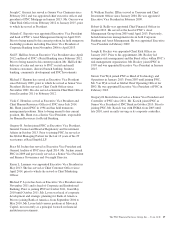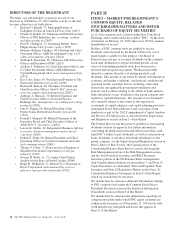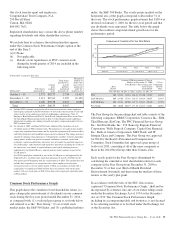PNC Bank 2014 Annual Report Download - page 37
Download and view the complete annual report
Please find page 37 of the 2014 PNC Bank annual report below. You can navigate through the pages in the report by either clicking on the pages listed below, or by using the keyword search tool below to find specific information within the annual report.covered funds subject to the Volcker Rule regulations
totaling approximately $579 million, including $140
million of sponsored funds. Certain of PNC’s REIT
Preferred Securities also were issued by statutory
trusts that, as currently structured, are considered
covered funds. As of December 31, 2014, PNC also
held approximately $1.5 billion of senior debt
interests in collateralized loan obligations and certain
other investment securities that may be considered
ownership interests in covered funds. The unrealized
loss associated with these securities was
approximately $11 million. In December 2014, the
Federal Reserve extended the conformance period for
the Volcker Rule, which generally goes into effect on
July 21, 2015, to give all banking entities until
July 21, 2016 to conform their investments in, and
relationships with, covered funds that were in place
prior to December 31, 2013 (legacy covered funds).
Moreover, the Federal Reserve also indicated its
intent to grant an additional one-year extension of the
conformance period for legacy covered funds in
order to permit banking entities until July 21, 2017 to
conform their ownership interests in, and
relationships with, these funds. Substantially all of
PNC’s interests in covered funds qualify for the
extended conformance period granted for holdings in
legacy covered funds. Moreover, certain of PNC’s
legacy covered funds may qualify for an additional 5-
year conformance period (i.e., until July 21, 2022),
subject to Federal Reserve approval. It is likely that
at least some of the amounts invested in legacy
covered funds will reduce over time in the ordinary
course before compliance is required. A forced sale
or restructuring of PNC’s investments due to the
Volcker Rule would likely result in PNC receiving
less value than it would otherwise have received or
experiencing other adverse consequences.
• In February 2014, the Federal Reserve issued final
rules establishing new enhanced prudential standards
relating to liquidity risk and overall risk management
for BHCs (like PNC) that have $50 billion or more in
consolidated total assets. The Federal Reserve,
however, continues to develop the other enhanced
prudential standards that are required under Dodd-
Frank for bank holding companies with $50 billion or
more in consolidated total assets, including the
counterparty credit exposure limits and early
remediation requirements that were the subject of
proposed rules issued in December 2011. Under these
proposed rules, PNC could be subject to increasingly
stringent actions by the Federal Reserve if its
financial condition or risk management deteriorated
as reflected by the company’s current or projected
post-stress capital levels, compliance with
supervisory liquidity and risk management standards
and, in some instances, market-based indicators, such
as credit default swap spreads. In addition, the
Federal Reserve has indicated that it intends to
continue to develop the set of enhanced prudential
standards that apply to large bank holding companies
in order to further promote the resiliency of such
firms and the U.S. financial system. Until the Federal
Reserve’s rules and initiatives to establish these
enhanced prudential standards are completed, we are
unable to fully estimate their impact on PNC,
although we expect these initiatives will result in
increased compliance costs.
• In October 2014, six federal agencies (the Federal
Reserve, OCC, FDIC, SEC, Federal Housing Finance
Agency and the Department of Housing and Urban
Development) adopted final rules to implement the
credit risk retention requirements of Section 941 of
Dodd-Frank for asset-backed securitization
transactions. The regulations specify when and how
securitizers of different types of asset-backed
securitizations, including transactions backed by
residential mortgages, commercial mortgages, and
commercial, credit card and auto loans, must comply
with the Dodd-Frank requirement that they retain at
least five percent of the credit risk of the assets being
securitized. The final rules also implement the
exemptions from these credit risk retention
requirements for transactions that are backed by
“qualified residential mortgages” or other high-
quality commercial mortgage, commercial or
automobile loans, each as defined in the final rules.
The regulations will take effect on December 24,
2015 with respect to new securitization transactions
backed by residential mortgages and on
December 24, 2016 with respect to new securitization
transactions backed by other types of assets. The
final rules are likely to have an impact on PNC both
directly as well as indirectly. The extent and
magnitude of these impacts is not yet known and
will, to some extent, depend on how the markets and
market participants (including PNC) adjust to the
new rules.
On the indirect impact side, PNC originates loans of a
variety of types, including residential and commercial
mortgages, credit card, auto, and student, that
historically have commonly been securitized, and
PNC is also a significant servicer of residential and
commercial mortgages held by others, including
securitization vehicles. PNC anticipates that the risk
retention requirements will impact the market for
loans of types that historically have been securitized,
potentially affecting the volumes of loans securitized,
the types of loan products made available, the terms
on which loans are offered, consumer and business
demand for loans, and the market for third-party loan
servicers. The risk retention rules also could have the
effect of slowing the rebound in the securitization
markets. One effect of having substantially reduced
The PNC Financial Services Group, Inc. – Form 10-K 19


